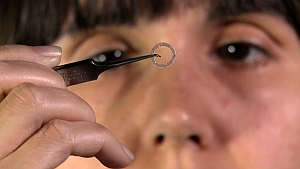
Ílida Ortega Asencio, examines a disc of biodegradable material which can be fixed over the cornea. (University of Sheffield)
Engineers at University of Sheffield in the U.K. devised a new method for attaching stem cells to eyes that can lessen the need for tissue banks and reduce the growth of scar tissue on the eye. The technology, designed to treat damage to the cornea, the transparent layer on the front of the eye, is described online in the journal Acta Biomaterialia (paid subscription required).
Standard treatments for corneal blindness are corneal transplants or grafting stem cells onto the eye using donor human amniotic membrane as a temporary carrier to deliver these cells to the eye. The treatment can fail after a few years, in some cases, if the repaired eyes do not retain these stem cells that perform constant repair of the cornea. Thick white scar tissue can form on the cornea, causing partial or complete sight loss, if these repairs are not performed.
The technique developed by the Sheffield team, led by first author and EPSRC Fellow Ílida Ortega Asencio, produces membranes to help in the grafting of stem cells onto the eye, mimicking structural features of the eye itself. (EPSRC is the Engineering and Physical Science Research Council, a science funding government agency in the U.K.) “The disk has an outer ring containing pockets into which stem cells taken from the patient’s healthy eye can be placed,” says Ortega Asencio. “The material across the center of the disk is thinner than the ring, so it will biodegrade more quickly allowing the stem cells to proliferate across the surface of the eye to repair the cornea.”
The Sheffield team adapted techniques from the semiconductor and advanced materials industries, such as microstereolithography and electrospinning, to make a disk of biodegradable material, which can be fixed over the cornea. The disk is loaded with stem cells, which then multiply, allowing the eye to heal naturally.
The disk contains niches or pockets to house and protect the stem cells, resembling the niches found around the rim of a healthy cornea. The researchers designed the small pockets built into the membrane to help cells group together and act as a reservoir of healthy replacement stem cells in the eye.
Early applications of this technique are expected to be in the developing world, where treating corneal blindness is a particularly pressing problem, from high rates of chemical or accidental damage to the eye. In addition, complex treatments such as transplants or amniotic membrane grafts are not available to a large part of the population.
The researchers tested the stem cell disks on lab rabbits that engineering professor and co-author Sheila MacNeil says, “have shown that the membranes will support cell growth.” The next stage says MacNeil is clinical trials with patients at the LV Prasad Eye Institute in Hyderabad, India.
“One advantage of our design is that we have made the disk from materials already in use as biodegradable sutures in the eye so we know they won’t cause a problem in the body,” adds MacNeil. “This means that, subject to the necessary safety studies and approval from Indian regulatory authorities, we should be able to move to early stage clinical trials fairly quickly.”
More generally, says Sheffield materials science professor and co-author Frederik Claeyssens, the new technique can reduce the need for tissue banks that generate the cultured cells from donor tissue, but also raise risks of disease transmission with living human tissue. “By using a synthetic material, it will eliminate some of the risk to patients and be readily available for all surgeons,” says Claeyssens. “We also believe that the overall treatment using these disks will not only be better than current treatments, it will be cheaper as well.”
Read more:
- Pilot Clinical Trial Indicates Glaucoma Drug Efficacy
- New Artificial Corneas Advance to Animal Testing
- Microneedle System Developed to Deliver Drugs to Eyes
- Older Americans Experiencing Fewer Vision Problems
- Patent Awarded for Sustained Release Drug Implant in Eyes
* * *

 RSS - Posts
RSS - Posts
[…] New Technique Developed for Stem Cell Delivery to Eyes […]